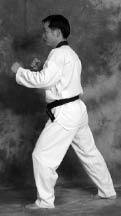Complete Kicking (14 page)
Authors: Turtle Press

4. After kicking, control your foot as you complete the outward arc and return to fighting stance. Maintain your center on your standing leg throughout the kick so your kicking leg is easier to control.
FOR STRONG FLEXIBLE KICKS
Kicks like crescent kick and axe kick derive their power from a large range of motion, so they require flexibility as much as muscular strength.
To develop power in these kicks, try using a bike tube or resistance band, with one end attached to a fixed object and the other to your ankle. Perform your kicks so that they are traveling away from the fixed end of the band, creating resistance for each repetition. Control your kicks to avoid injuring your joints during resistance training.
As you get stronger, add more tubing or heavier tubing to increase the resistance.
applications
Outside crescent kick is useful for kicking at or knocking away anything entering the vertical centerline of your body. You can kick an opponent’s face or you can use your foot to deflect a punch, grab or kick. Outside crescent kick can strike a target with the bottom of the foot, the blade, the ankle, or even the shin.
* Begin with a low kick and kick higher as you get used to the motion.
SELF-DEFENSE APPLICATIONS
Just after an opponent finishes an attack, counter with an outside crescent kick to the face using the bottom of the foot (timing and distance are the key factors).
Strike the assailant’s knife wielding hand with the ankle of your outside crescent kick.
Use the long range of the outside crescent kick to knock the opponent’s punching hand away (attack while defending).
* Outside crescent kick should be used with follow-up techniques such as:
Outside crescent kick + rear hand punch
Outside crescent kick + rear elbow strike
Outside crescent kick + rear leg front kick
Outside crescent kick + rear leg roundhouse kick
Outside crescent kick + rear leg knee kick
common mistakes
MISTAKE 1: Raising the leg straight upward.
SOLUTION: Balance and the correct arcing motion are the most difficult to achieve with this kick. If you have trouble making the in-to-outward arc, start at waist level where it is easier to control your leg.
MISTAKE 2: Bending your torso or leaning backward.
SOLUTION: When your upper body is tilted and the muscles are tight, the arc of your kick becomes smaller and you lose your balance. Focus on keeping your head upright and your shoulders relaxed. Emphasize flexibility rather than power.
• remember
1. Keep your head upright.
2. Relax your shoulders.
3. After kicking, let your foot go and repose your body naturally.
• avoid
1. Bending the torso
2. Raising the leg straight upward
3. Leaning backward
INSIDE CRESCENT KICK
purpose
Inside crescent kick is used to strike a close-range target located in front of you. The out-to-inward trajectory makes it a good surprise attack. The target is usually the face or side of the head. It is also useful for chopping downward on the clavicle area.
key points
Slap the target with your foot from the outside. Relax your shoulders, erect your spine and raise your foot lightly before releasing it into the target. Use the element of surprise to catch your opponent off guard.
striking area
Bottom of the foot, heel
targets
1. face
2. chest
3. clavicle
how to
1. From fighting stance, shift your weight to the front leg.
2. Bring your rear leg up about 15° outside of the target line. Snap the inner bottom of the foot inward in an arc to the target (usually the face or head). You can impact the target horizontally or at a diagonally downward angle.
3. To finish, continue through the target and return to fighting stance.
Your head should be at the vertical center at all times while your hands travel in the opposite direction of the kick for balance and power.
*Kick only flexible targets with inside or outside crescent kick. Kicking an immovable target can damage your knee or hip.
applications
Inside crescent kick has a surprise element that can be used to intimidate an eager opponent. It is useful when the opponent attacks your middle or low section, when he lands short after an attack, or when he has a weapon in his hand. The swinging of your foot should be well timed to hit a moving target. Strive for a light, fast and precise kick.
SPORT APPLICATIONS
Counter your opponent’s punch to the stomach with an inside crescent kick to the temple.
Other books
The Deed by Keith Blanchard
Lady Windermere's Fan by Wilde, Oscar
Fathers and Sons by Ivan Turgenev
Blade of Tyshalle by Matthew Woodring Stover
More Than Friends by Erin Dutton
Big Boned by Meg Cabot
Dream Dark by Kami Garcia
The Last One Left by John D. MacDonald
Every Soul a Star by Wendy Mass







